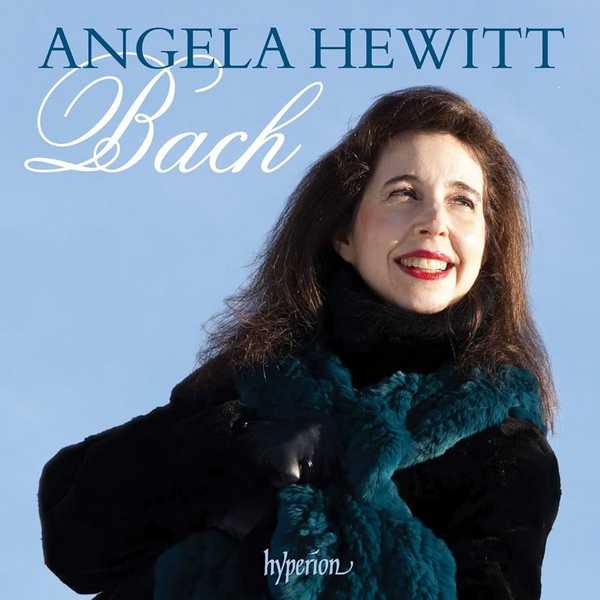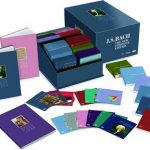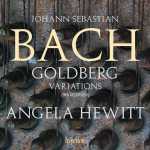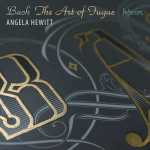
Composer: Johann Sebastian Bach
Performer: Angela Hewitt
Number of Discs: 16
Format: FLAC (image+cue)
Label: Hyperion
Catalogue: CDS44421-35
Release: 2010
Size: 3.05 GB
Recovery: +3%
Scan: yes
CD 01
Fantasia in C minor, BWV 906
Fifteen Two-Part Inventions, BWV 772-786
Fifteen Three-Part Sinfonias, BWV 787-801
Chromatic Fantasia and Fugue, BWV 903
CD 02
English Suite No.1 in A major, BWV 806
English Suite No.2 in A minor, BWV 807
English Suite No.3 in G minor, BWV 808
CD 03
English Suite No.4 in F major, BWV 809
English Suite No.5 in E minor, BWV 810
English Suite No.6 in D minor, BWV 811
CD 04
Sonata in D minor, BWV 964
French Suite No. 1 in D minor, BWV 812
French Suite No. 2 in C minor, BWV 813
French Suite No. 3 in B minor, BWV 814
Six Little Preludes, BWV 924-928, 930
CD 05
Six Little Preludes, BWV 933-938
Six Little Preludes, BWV 939-943, 999
French Suite No. 4 in E flat major, BWV 815
French Suite No. 5 in G major, BWV 816
French Suite No. 6 in E major, BWV 817
Prelude and Fugue in A minor, BWV 894
CD 06
Partita no. 1 in B flat major, BWV 825
Partita no. 2 in C minor, BWV 826
Partita no. 4 in D major, BWV 828
CD 07
Partita no. 3 in A minor, BWV 827
Partita no. 5 in G major, BWV 829
Partita no. 6 in E minor, BWV 830
CD 08
Das Wohltemperirte Klavier Book I
Preludes and fugues BWV 846-869, Nos 1-12
CD 09
Das Wohltemperirte Klavier Book I
Preludes and fugues BWV 846-869, Nos 13-24
CD 10
Das Wohltemperirte Klavier Book II
Preludes and fugues BWV 870-893, Nos 1-12
CD 11
Das Wohltemperirte Klavier Book II
Preludes and fugues BWV 870-893, Nos 13-24
CD 12
Italian Concerto in F major, BWV 971
Capriccio in B flat major, BWV 992
Capriccio in E major, BWV 993
Four Duets, BWV 802-805
French Overture in B minor, BWV 831
CD 13
Goldberg Variations, BWV 988
CD 14
Toccata in C minor, BWV 911
Toccata in G major, BWV 916
Toccata in F sharp minor, BWV 910
Toccata in E minor, BWV 914
Toccata in D minor, BWV 913
Toccata in G minor, BWV 915
Toccata in D major, BWV 912
CD 15
Fantasia and Fugue in A minor, BWV 904
Aria Variata ‘alla Maniera Italiana’, BWV 989
Sonata in D major, BWV 963
Partie in A major, BWV 832
Suite in F minor, BWV 823
Adagio in G major, BWV 968
Fugue in C major, BWV 953
Jesu, meine Zuversicht, BWV 728
Wer nur den lieben Gott lässt walten, BWV 691
Fantasia and Fugue in A minor, BWV 944
angela-hewitt-bach-02.rar – 225.2 MB
angela-hewitt-bach-03.rar – 228.2 MB
angela-hewitt-bach-04.rar – 201.5 MB
angela-hewitt-bach-05.rar – 214.1 MB
angela-hewitt-bach-06.rar – 198.2 MB
angela-hewitt-bach-07.rar – 199.4 MB
angela-hewitt-bach-08.rar – 147.5 MB
angela-hewitt-bach-09.rar – 147.6 MB
angela-hewitt-bach-10.rar – 188.9 MB
angela-hewitt-bach-11.rar – 194.5 MB
angela-hewitt-bach-12.rar – 220.3 MB
angela-hewitt-bach-13.rar – 217.1 MB
angela-hewitt-bach-14.rar – 212.6 MB
angela-hewitt-bach-15.rar – 202.6 MB
angela-hewitt-bach-16.rar – 211.0 MB
‘I’ll take it!’ said Ted Perry, Hyperion’s managing director over the telephone. ‘But you haven’t heard it yet!’ I exclaimed. ‘I don’t need to—I know it will be good’, was his reply. ‘But only if you agree to record the complete Bach.’ My dream had just come true.
That was in early 1994 when I had taken it upon myself to record a CD of the Two- and Three-Part Inventions, along with the Chromatic Fantasia and Fugue and the C minor Fantasia. Eight years before, Deutsche Grammophon had released a Bach recording I had done for them soon after winning the Toronto International Bach Piano Competition. It sold extremely well, got great press, and was nominated for a Gramophone Award. From what I understood, however, their marketing department decided I was not catchy enough to continue making records for them. So I bided my time, gave a huge number of concerts, learned more repertoire, and continued to grow as an artist and person. That wasn’t a bad thing. But by late 1993 I simply was not willing to wait any longer. As is typical of me, I took matters into my own hands. I got some funding from a Canadian investment bank, Wood Gundy (thanks to their London manager who had been a chorister in my father’s choir in Ottawa and had grown up in our neighbourhood), and also from the Canadian High Commission in London. The rest I put in myself. I asked my former producer at Deutsche Grammophon, Otto Ernst Wohlert (who had since taken early retirement; he was best known for working with Karajan on his early Beethoven cycle for DG), to produce it and to find me the rest of the team and a suitable venue. We decided on the Beethovensaal in Hannover where they had a Steinway on which Kempff had made several recordings (including his wonderful one of Bach transcriptions). A young ‘Tonmeister’ (sound engineer) was recommended by DG as one of their ‘bright lights’. His name was Ludger Böckenhoff. The tuner was to be Robert Ritscher who had also done my DG recording, but at the last minute he wasn’t available, so Gerd Finkenstein was sent in his place. I remember those sessions as though they were yesterday.Experience at recording came to me as a tiny girl. My father had sophisticated recording equipment for the time (a Magnecorder) and when I was four years old he taped me and my brother playing our respective exam pieces at home and in the hall of Christ Church Cathedral in Ottawa, where he was organist. I still have a copy of those tapes. He always meant to splice them together, taking out the mistakes, but he never did. Instead we get me playing an Andante by Steibelt about ten times in a row until it was perfect. Listening to what I’ve just recorded, and then striving to improve on the first version, has always been fascinating to me. To this day I have more or less kept the pattern established in that first recording in Hannover. After listening intently to the first two versions of a complete work (in this case I played all fifteen Inventions in one go), for the third time I make it more like a live performance and invite Ludger and Gerd to sit in the hall. That almost always makes me play better.
It had been agreed that I would hand over the finished master of this recording to a small Swiss label for production and distribution. When I was about to do so, something made me stop. I sensed it wasn’t the right thing to do. It was still my own property, so I contacted all the major labels to ask if they wanted it. None did. One maintained that Bach on the piano simply wasn’t marketable in those days of the ‘authentic’ instrument craze. Another said they were already committed to another pianist in that repertoire (I never figured out who that was). Yet another didn’t reply. Then I thought of Hyperion. I had written to Ted Perry several years before, but Tatiana Nikolayeva had already done the Art of the Fugue and the Goldberg Variations for them, and there was no space for another Bach pianist. Sometimes timing is everything: Nikolayeva had died only a few months before, so I thought I would try my luck again. It took Ted less than ten minutes to respond to the fax I wrote him.
It was good of Ted to let me keep my team in Germany. He knew I was happy with them and accepted not to change that, even though it would cost him more. We immediately planned the next release for the following year—a double-CD with all the French Suites, eighteen Little Preludes, the D minor Sonata and A minor Prelude and Fugue. I purposely started with those ‘easier’ pieces (though nothing is easy in Bach—I remember performing the Little Preludes in concert and never was I so nervous in my life), because I knew I couldn’t ever approach The Well-Tempered Clavier seriously without first having a very thorough grounding in the dance movements of the suites. For all of the Bach recordings (with the exception of the Goldberg Variations) it always was a mixture of pieces I had played before—some since I was very young—and others that were completely new. That is why I made a point of performing just about everything in the cycle first in public at least once if not many times before recording (and from memory).
The recording of the Partitas was a big step for me. I had previously played only the first and fifth while in my teens. I took my time over it, and studied them intensely. I couldn’t begin to count the hours I put into each of these recordings. It meant giving up a lot of other things in my life and my career—chamber music for one. Previously I had done quite a bit, but for Bach you need space and perfect concentration, and I remember a moment when I was learning a Trio for piano, clarinet, and bassoon by Glinka and thought: no—I have to stop this, at least for the time being. (I am now happily playing chamber music again.) I also remember meeting Trevor Pinnock on a flight from Ottawa to London during these years, and he said he wanted to get back to playing more Bach on the harpsichord but that it required such an enormous amount of time and commitment. I couldn’t have agreed more.
After the first CD of the Partitas was finished, I realized that I had to make a change in my recording team. My producer, Otto Ernst Wohlert, had become a close friend (in fact I stayed with him and his wife while making these first recordings, and they attended many of my recitals in Germany) and had once said to me that I must tell him when I felt it was time for him to stop (I suppose by then he was already past the normal retirement age). In the sessions I came to realize that there were things he was missing that needed to be fixed. Ludger heard these, and much more, and would come to find me in the break, score in hand, to quickly tell me without Otto Ernst finding out (there was, especially in Germany and for that generation, a hierarchy to be respected). That was the kind of help I wanted and needed, and felt I wasn’t getting. It was a sad day for me when I felt I really must say something. I wrote to Otto Ernst and tried to put it as nicely as I could, thanking him for all the wonderful work he had done for me, and very much hoping that we could remain friends. Unfortunately it didn’t go down well, and we never had any further contact. These things happen in life, and you move on.
The second CD of the Partitas was therefore the first one I did with Ludger as ‘Aufnahmeleiter’, which can be translated as record producer, but involves quite a bit more than one might imagine. Ludger had been trained at the famous Tonmeister Institute in Detmold, and apart from all the technical studies, there was a great emphasis on the musical aspects of recording. I found myself being told that my trills weren’t precise enough, that I could bring out the different voices more clearly, that I was rushing, that yes, something was very good, but perhaps it could be better. He would even scold me for the occasional clicking of my finger nails, and was unerring at hearing extraneous technical noises, whether from the piano’s action or in the actual recording. We always had a great mutual respect for each other, and the Bach cycle (as well as all the other recordings we have done for Hyperion) has seen us grow together in knowledge and experience. Ludger was also at the forefront of the advances in digital technology. Already with the French Suites we began doing the editing together in his studio in Detmold. Normally an already finished first edit is sent to the musician for his or her comments before another one is done. That whole process can take ages with constant back and forth. We would get through an entire CD in just a few days, and along the way make important artistic decisions. What I love about working with him is that I never walk out of the studio wondering if we have everything the way I wanted it. I always know we do. That is a great feeling.
In 1997, people were already planning concerts for the Bach anniversary year in 2000. Everyone was asking me when I would approach The Well-Tempered Clavier. Now that I had learned so much about rhythmic alterations in Baroque music (not playing exactly what is written in the score), articulation and especially the marked characteristics of each dance movement, I decided to plunge in. Within the next two years, I tackled twelve Preludes and Fugues every six months or so—always performing them in public and working hours on end to memorize them. It turned out to be the biggest challenge of my life. For sure I spent more hours with Bach than any living person during those years. We considered changing pianos and recording venues, but I was comfortable on the ‘Kempff’ Steinway, despite its slightly nasal tone. It inspired me. I still felt there was great life in its action and it wasn’t difficult to play. We did change the position of the piano in the Beethovensaal, however, removing a large portion of the seats and bringing it down off the stage to somewhere in the centre. I’m sure the holes we drilled in the floor to make sure we put it in the same place during those two years are still there!
The editing of the 48 Preludes and Fugues was a lesson in itself. The slightest difference in tempo or phrasing meant that two versions often could not be put together. And with voices tied over and musical phrases having to make sense, this took a great deal of concentration and musical intelligence. It was unbelievably tiring work, but also immensely satisfying. When I gave my first complete performances of The Well-Tempered Clavier during the 1999–2000 season, I knew I was well prepared.
The next CD had to be the Goldberg Variations. I had learned them for the International Bach Competition of Washington D.C. when I was sixteen years old, and had already performed them for a quarter of a century. It was one of my warhorses, yet to record it was something else entirely. Putting down on tape a work of such monumental proportions would be a huge statement, and of course everyone would compare it to the two recordings of the piece by my compatriot Glenn Gould. I really didn’t care about that—I just wanted to do my very best. Previously in concert I had never done all of the repeats, so that was one thing to change as I felt it wouldn’t be taken seriously otherwise (although Gould never did). Working up to the recording, I saw how that opened up so many more possibilities for interpretation—doing things slightly differently the second time round. It almost became another piece.
The aging Steinway in Hannover simply didn’t seem up to the task, so we made a change of instrument and venue. A few years before, Ludger and I had made a brief tour of possible recording venues in England and had visited Henry Wood Hall in London—a former church which is now a rehearsal hall for the major London orchestras as well as a superb recording facility. We used a Steinway that Gerd Finkenstein had in his own collection which was, and I believe still is, a beautiful piano. The only problem was getting it to England. Gerd fortunately loves to drive, so he simply put it in a trailer, hitched it on to his car, and off he went, getting the ferry across the English Channel. I think I even went down to Dover the first time he came over, and he followed me and a friend in his car so he wouldn’t get lost trying to navigate south London, let alone confused driving on the left side of the road for the first time! Ted Perry had generously given me five days for the sessions. I am forever grateful to him for that. Otherwise what subsequently happened might never have happened at all.
On the first day, after setting up and finding a sound we liked, I played a complete version—eighty minutes without stopping. Ludger and I (and Ted, I think, as he came along to visit us) listened to it all, marking in the score what we liked and disliked, what needed to be re-thought—so many things. For the next three days, we covered ten variations a day, having it all ‘in the can’ by the early evening of day four. For a break we went up to Oxford Street and had a Japanese meal, and I had a quick massage with my therapist nearby. Around 9 or 10 p.m. we returned to Henry Wood Hall. Gerd had done something to the action of the piano to make it even more responsive, and Ludger encouraged me to play the opening Aria once more. Nothing is more important than the beginning. So I did. It was good. ‘Keep going’, he said. ‘But it’s 11:15 at night—surely they’ll kick us out of here!’ I said. ‘No they won’t.’ So between then and 12:45 a.m. I gave the performance of my life of the Goldberg Variations (at least up until then!). I only stopped at the half-way point (after Variation 15) to whisper: ‘Do we have enough tape?’ (While listening in Ludger’s studio to the master CD of the Goldberg Variations that was to be sent to Hyperion, we both suddenly jumped at this point. By some fluke, my whispering that phrase could be heard during the pause between Variations 15 and 16! Of course we took it out immediately, but I still have the one CD with it left in.) I played for an audience of three: Ludger and Gerd, lying on the floor in the hall, and Gerd’s then wife, somewhere up in the balcony, stretched out on a pew. My body felt good; my interpretation felt liberated from all constraints; and my joy at the end was unbounded. I’ll never forget the feeling I had playing the final variation—that wonderful Quodlibet. To this day I try to recapture that every time I perform it. When I finished, we all knew we had something very special.
The only problem was that it was so different from what I had done on the previous days that we really couldn’t use any of that material for the inevitable patches. So on the fifth day we re-did whatever we thought might need covering. Still, something like 80% of the final recording comes from that one late-night performance.
I think it was after this recording that I decided to go back to Germany with Ludger, Gerd, his wife and the piano—making the cross-Channel trip on the boat, and then driving for hours in the stifling heat at the other end. We only did that once; never again. But it nevertheless remains a fun memory.
All of the remaining solo Bach recordings were done with that set-up in Henry Wood Hall: the Italian Concerto and French Overture in 2000, the Toccatas (one of my personal favourites of the whole cycle) in 2002; the English Suites in 2002–3, and the final ‘mopping up’ disc of miscellaneous works in 2004. Our days there were made even more enjoyable by the catering supplied by the staff. Full three-course meals were cooked for us at lunchtime, and my dietary needs (no wheat) were strictly adhered to. I stayed away from the rich desserts (the English Trifle was the favourite of the boys) which would slightly dull the senses of my team for about an hour afterwards. I was never good at concentrating when hungry, and as soon as I started making mistakes, we all knew it was time to stop for lunch. Interruptions were not many (which was amazing for central London). I can remember only a few occasions when the rain on the roof was so loud we really couldn’t go on, or else days when the typical English weather of sun one minute and clouds the next would result in the roof creaking. And once some computer glitch meant we had to completely redo the Sixth English Suite. I always respond to pressure, though, and the resulting performance was better than what we would have had without the technical intervention. I remember Ludger telling me to give a ‘hair-down’ performance of that final Gigue, so I really went for it. He was always great at knowing when I could go even further and risk more. Often I would surprise him, though, and do it without prodding. He would be about to declare a piece finished when I wanted to do it one last time. Occasionally that worked for the better.
In 2004, just over ten years after the first recording, we had got through all of the major solo keyboard works of Bach. What a journey! It had given shape to my life and my career in a way that nothing else could have done. Of course if you listen to those first recordings and the last ones in the set, you will hear a difference—not just in sound quality but more importantly in the way I play. If I recorded the Partitas again, they would be different still. But does that matter? What was important to me was that after every recording session, when the microphones were taken down and the piano was loaded back into the van, I felt extremely happy. I felt I had done the best I could do. The fact that this set is also a document of my own personal growth as a pianist and person only adds, I hope, to the overall impact.
But then …
I continued to have many requests to perform The Well-Tempered Clavier around the world. Not being a piece that one can play at the drop of a hat (after all it is four and a half hours of the most difficult music to memorize and play), I decided to devote my entire 2007–8 season to what was called my Bach World Tour. From South Africa to South America, Sydney to Shanghai, Los Angeles to Ottawa, Glasgow to Warsaw … I performed the entire cycle in twenty-six countries on six continents over a period of fourteen months. For the occasion, Hyperion re-released my 1997–8 recording of it as a special boxed set. Even before the tour started, however, I knew I wanted to record it again. One of the things I’m most proud of is convincing Simon Perry (Ted’s son, who took over the management of Hyperion after Ted’s death in 2003) to allow me to do so. It took some persuading. At first we thought a live recording would be best, but logistically that was a nightmare. In the end, one month before the end of the tour, I gathered with my team in the Jesus-Christus-Kirche in Berlin. We did the whole thing (4 CDs) in seven days—listening and all. It is this version of The Well-Tempered Clavier that is included in this boxed set. The huge amount of experience and sheer time I had spent with the work during my world tour meant that large parts of it came without editing. Still, when those microphones are so close, attention has to be paid to every detail. The acoustics were inspiring, and I was playing my own gleaming Fazioli concert grand, brought from my home in Umbria. I remember bursting into tears at the end of the B minor Fugue from Book 1—an immense arc of great intensity—which I played only once. That alone showed me that all the long hours spent with Bach had been worth it.



